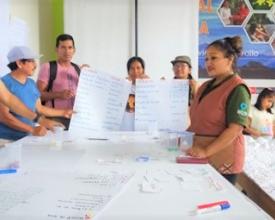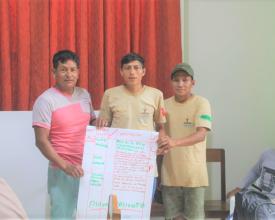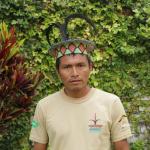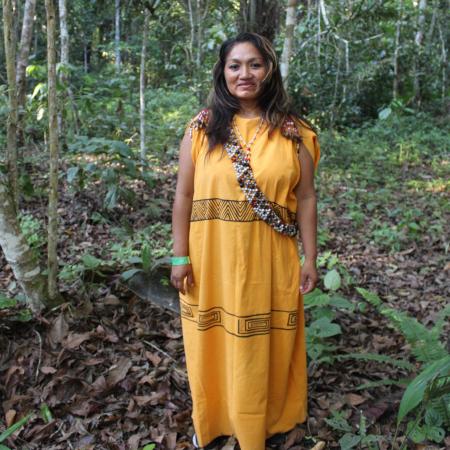
Three-dimensional mapping to build territorial agreements: the experience of AMARCY, the indigenous administrator of the Yanesha Communal Reserve.
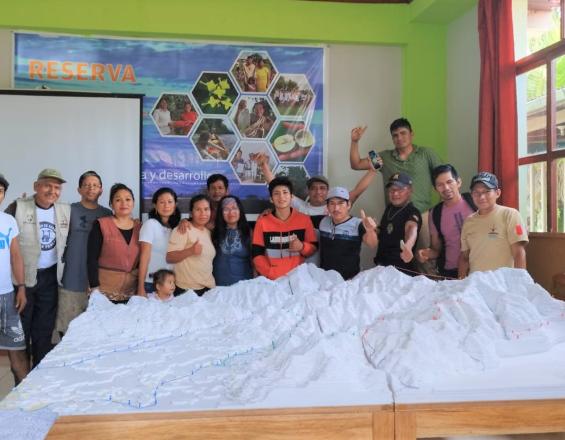
In the Yanesha Communal Reserve, a protected natural area administered by ECA AMARCY (indigenous administrator) and the Peruvian State, ECA AMARCY has led the process of elaborating the three-dimensional mapping of the reserve. This method is based on the extraction of topographic information (contour lines, scale maps) and the construction of a physical model that is used to locate people's memories of the territory. A tool whose participatory construction process has contributed to the strengthening of the ECA AMARCY, to the construction of a map of their ancestral territory by the population of the communities and annexed colonist partners of the Reserve, to the compilation of information for the rescue of knowledge and the revaluation of the Yanesha culture; and to the improvement of the dialogue on the uses of the territory for an effective management of the Reserve, with full and effective participation of the indigenous peoples that in the communal reserves have the right to the management and use of the natural resources.
Context
Challenges addressed
- Mobilizing the wise men to the communities due to the distance from the Reserve
- Doing this type of work for the first time has been a challenge.
- Most of the wise people communicate in their mother tongue, the Yanesha language, and the young people no longer speak it, so language has also been a challenge.
- It took a long time to create a space where the wise people could share their knowledge, but we were able to do it.
Location
Process
Summary of the process
The application of the intercultural approach (1) is one of the bases of the co-management model, a territorial management model in which the Peruvian State and the indigenous peoples share and assume obligations in the administration of the communal reserve. The intercultural approach in working with indigenous peoples is the starting point to ensure a participatory appropriation of tools (2), because through a better understanding of the Yanesha people's cosmovision, a climate of trust is ensured that facilitates the full and effective participation of the community members, sharing experiences and information that contributes to the rescue of ancestral knowledge (3). This action is one of the pillars of REDD+ Amazon Indigenous REDD+ (RIA), the indigenous peoples' climate ambition strategy that is being implemented in the communal reserves by the National Association of Contract Executors for the Administration of Communal Reserves of Peru (ANECAP) and the ECAs.
Building Blocks
Cross-cultural approach
The principle of interculturality is one of the three pillars on which the co-management model is built, together with the pillars of transparency and trust. The intercultural approach promotes respect and tolerance for the diversity of perceptions, conceptualizations and values that make up the cosmovision of the Yanesha indigenous people living in the communities surrounding the Yanesha Communal Reserve and that make up the Association for the Management and Conservation of the Yanesha Communal Reserve (AMARCY).
This principle of interculturality considers this reality and different conditions, giving it the same value and importance compared to the western view of the other party, promoting mutual respect, reciprocity and equity between the co-managers (ECA+Peruvian State).
Enabling factors
The same model of territorial governance of communal reserves: co-management. A territorial management model where the Peruvian State and the indigenous peoples, represented by the Executor of Administration Contract (ECA), share the administration of the communal reserve with their own and shared obligations. Within the framework of an indefinite administration contract, with non-delegable roles and functions.
Lesson learned
-The use of the intercultural approach is complex to apply in practice; it requires openness and respect for cultural differences, which begins by ensuring the full and effective participation of indigenous peoples through actions that allow them to understand the processes and gather their perceptions.
-The processes of participatory construction of geographic information involving indigenous peoples require more time, due to the complexity of the actors' perspective and the difficulty of concentrating all of them in the same space at the same time, considering the availability and dynamics of the community members.
Appropriation of tools in a participatory manner
Theparticipatory process of the construction of the three-dimensional mapping of the Yanesha Communal Reserve is a key factor for the community members to feel ownership of the tool: through workshops with the participation of young people, wise men, community leaders and women who have contributed to the elaboration of the model and the legend, among others.
In a protected natural area such as the Yanesha Communal Reserve, where indigenous peoples have the right to manage and use the natural resources, it is an obligation of the Management Contract Executor to encourage the participation of the partner communities it represents. Knowledge building processes that ensure the full and effective participation of indigenous peoples not only contribute to the appropriation of the knowledge generated, but also allow the characteristics that make a communal reserve different and unique to be rescued: the presence of indigenous peoples, which is why they were created.
Enabling factors
The territorial management model of co-management, with its own and shared responsibilities between the Peruvian State and the indigenous peoples, requires a shared management of the protected natural area. It encourages participation, which is essential for the subsequent appropriation of what has been built.
Lesson learned
-The use of these participatory tools allows for the appropriation of knowledge.
-In order to promote the full and effective participation of indigenous peoples, it is essential that the processes be led by local indigenous leaders, who, with the appropriate technical support, facilitate the construction of knowledge from an indigenous perspective.
-Training processes with indigenous peoples should preferably take place in person, to ensure a better understanding of the contents.
Rescue of ancestral knowledge
Thethree-dimensional mapping process of the Yanesha Communal Reserve has made it possible to rescue information that only the wise men knew and was unknown to many; to rescue ancestral roads, routes that were being forgotten and that can be used for the surveillance of the communal forests and the Reserve; to locate the colpas where the animals gather to drink water; the names of the streams in the native language, among others.
The rescue of ancestral knowledge is one of the pillars of REDD+ Amazon Indigenous REDD+ (RIA), the indigenous peoples' climate ambition strategy that is being promoted in the communal reserves and throughout the Amazon basin. These processes contribute to the implementation of this strategy, which AMARCY implements in the Yanesha Communal Reserve and is part of the Executor's financial sustainability strategy.
Enabling factors
The presence of an indigenous administrator (AMARCY), as part of the territorial management model, makes it necessary to consider at all times the existence of a cultural component that must be taken into account and incorporated in all management instruments, as well as in all corresponding planning.
Lesson learned
The strengthening of the ECA AMARCY has taken place within the framework of the process, but could have been greater with a face-to-face speaker.
Impacts
-Strengthening of the ECA AMARCY (Association for the Management and Conservation of the Yanesha Communal Reserve) as the indigenous administrator of the Yanesha Communal Reserve, which leads participatory processes for the effective management of the protected natural area and for the benefit of the communities and annexed colonist partners.
-The communities and annexed colonist partners of the Yanesha Communal Reserve have constructed a map of their own territory, the Reserve, which has allowed them to recognize their ancestral territories in the Palcazú Valley.
-Important information has been compiled for the rescue of ancestral knowledge and the revaluation of the Yanesha culture, such as the names of the sacred places where the ancestors of the Yanesha people walked, places like Neblina Hill, for example, which has a lot of meaning for the Yanesha people.
-Dialogue on the uses of the territory was improved.
Beneficiaries
Direct:
-CCNN:
Siete de Junio (1500)
Nueva Esperanza (400)
Alto Lagarto (80)
-Anexos colonos:
Playa Caliente (40)
La Cantuta (50)
Ataz (30)
Convento (35)
Santa Maria (40)
Indirect:
All 10 communities and 6 annexed colonist members of the Yanesha Communal Reserve.
Sustainable Development Goals
Story

Herlita Crispín Soto, member of the Board of Directors of ECA AMARCY
Throughout the year 2021 and 2022 the co-management of the Yanesha Communal Reserve carried out the application process to the IUCN Green List, following the path traced by the Amarakaeri Communal Reserve that was incorporated in 2018. This enriching process led the Amarcy/Sernanp co-management to order and systematize information around the indicators established for the nomination. In this context of coordination and exchanges with the IUCN, the opportunity arose for Amarcy, as indigenous administrator of the Reserve, to undertake the elaboration of a three-dimensional mapping of this protected natural area, ancestral territory of the Yanesha people.
"The workshops of the mapping process and the elaboration of the model have been important for me, for my colleagues from the communities, community guards, women and children. The spaces have been enriching since experiences and knowledge about customs, flora and fauna were exchanged between representatives of the communities and authorities.
What stands out most about this process is that we can see the Yanesha Communal Reserve on a map without the need to go out into the field. In addition, we have identified the resources of the YYRC and the buffer zone, such as clay licks, waterfalls, streams, areas where there are plantations that allow us to work the land in a sustainable manner, educational institutions and communication routes. For us it has been very valuable to recognize what we can find in the RCY.
We also value the rescue of ancestral knowledge, through the participation of the Yanesha sages in the participatory workshops, which contributed to the strengthening of the ECA as an indigenous administrator.


